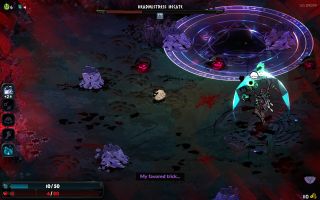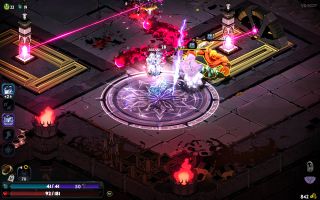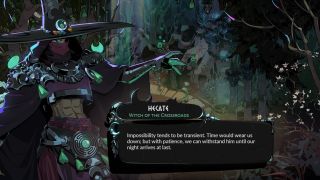If you’re struggling with Hades 2’s small changes, don’t worry—they’ll click

United States
Breaking News:
A Former Leader of the Hells Angels Motorcycle Gang Joins Trump in Court
Player ratings for Manchester City’s 2023-24 Premier League title winners | Jamie Jackson
From tails to (umbilical) arms, the hidden details in Lego’s new Artemis SLS rocket
US embassy owes £15m in congestion charge fees, says Transport for London
Liverpool confirm Arne Slot replacing Klopp as head coach on three-year deal
Washington DC
Monday, May 20, 2024

Plenty of things in Hades 2 are similar to things from the original. Your hangout pals still include a dominatrix-coded rival who gets in your way, a fit sadboy, and a ghost whose nickname starts with D and turns out to be a significant character from myth. Mechanically there’s plenty that feels familiar too. You can dash out of danger then dash-attack back in, switch between ranged and melee builds as your weapons and boons align, and avoid standing in the red circle where a boss is about to make a magic explosion happen.
That familiarity tripped me up at first, because there are some subtle but significant differences between how the two play. For starters, new protagonist Melinoë’s movement and combat style is much more deliberate than her brother Zag’s crackhead zippiness. Once you unlock Greater Reflex in the first Hades he becomes a dedicated multi-dash dude, but Melinoë doesn’t have that option—if you dash away from trouble only to land in more, you can’t just dash again with your middle finger extended, which is how I imagine Zagreus does it.
Instead, in Hades 2 you can sprint by holding down the spacebar after a dash. It’s not a huge boost to your speed at first, but you can improve that with the arcana and boons. Combine the 25% sprint boost from an upgraded arcana card with the Hephaestus boon that gives you an extra 50% speed and you’ll be running around like the Flash.
Still, there’s a wind-up to Melinoë’s animations that takes a while to get used to. Even with Vsync turned off there’s a noticeable moment’s pause, a green flash of magic that goes off before you commit to dashing and before the invincibility frames kick in. I got hit a lot because I was so used to Zag’s instant dashes, but in Hades 2 you have to think faster and pay closer attention to the way enemies telegraph their intent.
Hecate lives up to her role as your teacher in this regard. She spins like a top before setting off her big circular area-of-effect spell, and Amelia Tyler grunts with effort before each launch of those green waves and taunts you before casting the curse that turns you into a sheep. (The secret with that, by the way, is to dash into it rather than away. Its subsequent change of direction gives enough time for your dash to recharge so you can repeat the move several times, after which it fades.)

Finally, Hecate’s bullet-hades attack is there to teach you why sprinting is so important. She’s the first of several bosses who need to be lapped while damage effects circle them clockwise, climaxing with the second phase of the fight against Chronos. The titan of time fights you on a literal clock whose burning hands chase you around its face as they tick down.
Melinoë’s cast, activated by pressing Q, is another vital move because it lets you crowd-control. Though its precise effect changes based on your loadout, most of the time it’s there to freeze anyone who steps into it, letting you drop the thing as you back away then blatter enemies while they’re stuck in it. That’s especially important with the Moonstone Axe, whose mega damage is balanced by its powerful slowness—especially the last hit in the combo, which takes so long to land you could get pizza delivered while you wait.
Keep up to date with the most important stories and the best deals, as picked by the PC Gamer team.

The weapon that really emphasizes the difference between the two games is the Umbral Flames. This pair of torches felt like the worst weapon of all when I first tried it, firing out dinky little balls of light that do fuck-all damage. And yet, this was the weapon I got my first clears of both the current final bosses with. (He said, trying not to spoil things.)
The Umbral Flames are the first purely ranged weapon you unlock, with the right-click special attack an orbiting orb that spins around wherever you drop it. Instead of needing to dash in to take your swings, you can concentrate on moving between areas of safe ground, whether behind obstacles or in the spots a boss isn’t about to set on fire, timing your attacks in between. It takes longer to chip away their health, but you spend more time getting used to their patterns. Even after Hecate, Hades 2 keeps trying to teach you how to play it if you let it.

At first I was put off by these differences between the two games, but now it’s become so natural that when I fired up the first to compare I found myself trying to sprint and annoyed by its absence. Where Hades was happy for you to flit around like a bat on amphetamines, Hades 2 wants you to move more deliberately, to pay more attention to timing.
Which makes sense, when you think about it. This is a game where your literal objective is to kill time, after all.